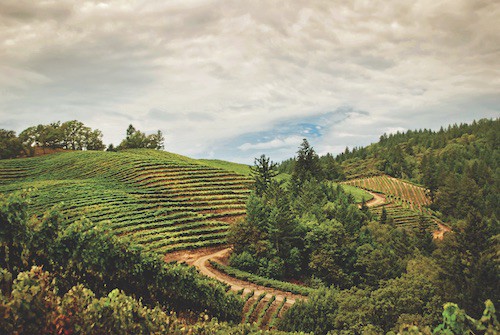Today, Winetraveler spoke with Immortal Estate Winery, Northern California’s newest winery situated on the mountainous border of Napa and Sonoma producing award winning wines. The vineyard is an organic evolution of Hidden Ridge Vineyard, a winery that has produced wines earning a rare 100-point rating from internationally influential wine critic Robert Parker.
Discover Immortal Estate
Could you provide some background on who the wine maker is for Immortal Estates? What is his/her experience?
Timothy Milos created Hidden Ridge Vineyard in 2004, in collaboration with Marco DiGiulio, and has been the sole winemaker since 2008. As a California native, Milos was pursuing a doctorate in molecular plant pathology at Cornell when he fell in love with the art of wine making. He redirected his academic career, and began studying Enology and Viticulture at U.C Davis, and working in the Napa Valley. Timothy started work at Hidden Ridge after working with a number of wineries, including Stag’s Leap Wine Cellars, Opus One and Cliff Lede Vineyard. He currently lives with his family in Napa.
What inspired the creation of this brand?
The new Immortal brand was created as a tribute to all things timeless. We each strive to place our lasting mark on the world and to leave a legacy. In wine making, we are hopefully able to create something beautiful that will outlive those currently working to conceive it. Our beautiful vineyard was terraced out of the hillside by the previous owner who unfortunately passed away from Cancer in 2016, but his work and legacy live on in the unique land. The immortal jellyfish is the only animal on the planet we know of that can live forever. It continuously reproduces its cell back to a youth state. Our mission at Immortal is to continue to reproduce our energy into this vineyard with wines that will last longer than the team creating them. We may be gone 50 years from now, but the wines we create will still be very much alive and drinkable. Our hard work and legacy will be left behind in each of the bottles we artfully produce.
What has the transition from Hidden Ridge Vineyards been like?
The transition from Hidden Ridge to Immortal has taken about two years. We didn’t want to forget the past, we actually have integrated that past into our future, so the transition was intentionally slow and methodical.
RELATED: The Perfect California Pacific Coast Highway Road Trip Itinerary
What is the terroir like of the property?
The Immortal Estate is located high in the rugged Mayacamas Mountains where we farm 50 acres of vines between 900 and 1700 feet in elevation, on mostly terraced slopes of up to a 55% grade. The vineyard consists of two adjacent sections: the upper section “hangs” from a promontory ridge line with East, South, and Western exposures, while the lower section sits on a massive ancient slide and has South, East and Northern exposures. Within each section there is rapidly changing topography, elevation, aspect, and soil. Soils range from decomposed volcanic ash, to fractured rock, to uplifted ancient seabed. While the vineyard usually sits above the fog line and experiences warm days, the site is impacted by ocean air flow from the Pacific Ocean, moderating the temperature in the mornings and evenings, preserving fruit and freshness in the wines. It is the diversity and complexity of the physical characteristics of the vineyard, its mountainside location, and the cooling breezes it receives that define the unique terroir of Immortal Estate.
What grapes are being grown and what wine styles produced?
We currently grow Cabernet Sauvignon and Petit Verdot on the property. We pair the diversity of our property with clonal diversity in the Cabernet to enhance the complexity of the wines. Our Cabernet Sauvignon is classically styled, rich in complexity, and matures over time. We are current replanting a small portion of the vineyard where we are adding Cabernet Franc and Malbec to be used in our Cabernet Sauvignon wines, and a small amount of Grenache, Mourvedre and Rolle, to make an estate rosé in the future.
Any unique production practices to discuss? What makes the brand unique?
Our wine is made according to neoclassical non-interventionist techniques. Much of the vineyard work is by hand, and we hand harvest. We pick on taste not chemistry. We choose the grapes according to areas of ripeness not vineyard blocks, and we keep these picking lots separate. The fruit is sorted, destemmed and sorted again before all going into small tanks. The fruit sits cold several days until natural fermentation begins and we pump over several times a day incorporating air during fermentation. We allow the new wine to macerate on the skins after fermentation and drain off when the wine is in balance by taste. Next, we age the wine in mostly new French Oak barrels from a number of select forests. The wine is usually racked three times, over about two years, and we bottle unfined and unfiltered.
Will you be allowing visitors for tastings, tours? If so, in what format / setting? What kind of experience(s) can they expect?
Right now we are doing private tastings with our hospitality team that spends a good amount of time educating people on our process, story and wine.
Any other news or events we should be aware of?
The Immortal Brand officially launched July 10, 2018 with the flagship wine Impassible Mountain. Our second wine will release this October, and it’s called Slope.


We are coming to Napa valley in the fall and would love to come to your winery for a tasting. We have fallen in love with your immortal slope and would also love to taste the impassable mountain. Would a tasting be possible?